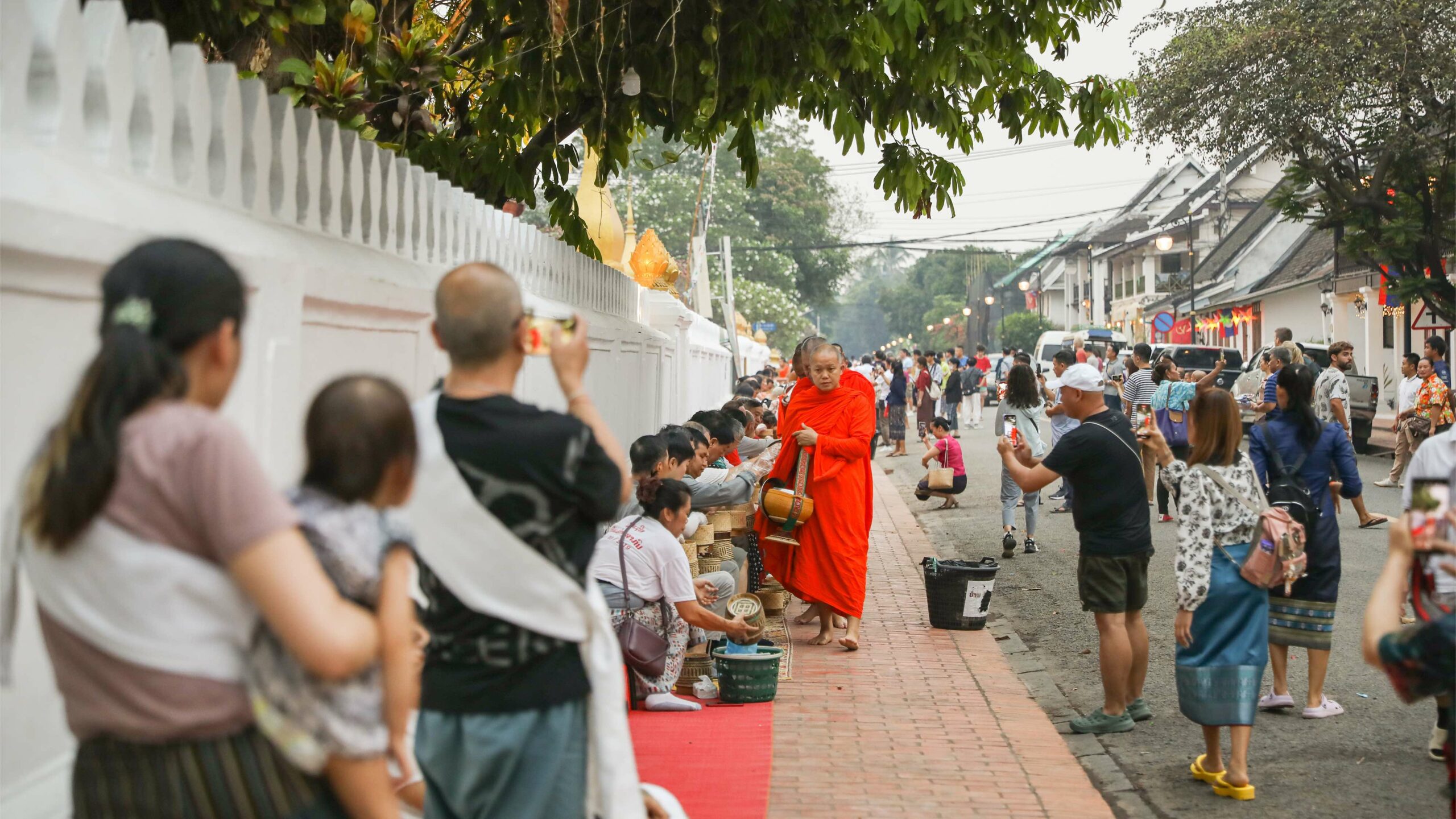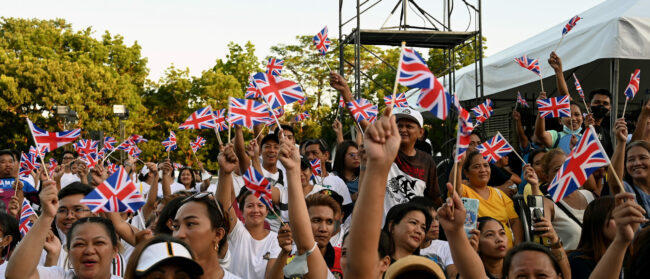Luang Prabang is known as a quiet oasis where children play on the banks of the Mekong River as families bring daily offerings to Buddhist monks in the town’s temples.
The Covid-19 pandemic brought a new kind of silence on the Lao cultural capital, effectively closing the country’s leading tourism destination. But as tourists now return en masse, clogging roads with minivans and snapping selfies with unamused monks, Luang Prabang is on the verge of profound changes that could reshape life in the UNESCO World Heritage town.
“Tourism is the key industry here. But while it’s good for our economy, it can also destroy our culture if it’s not properly disciplined,” said Soutthisak Sayasavanh, tour director at Discover Laos Today, a prominent travel company in Luang Prabang.
Some residents fear renewed pressures for development could erode the cultural identity and of the town, which is set on a peninsula at the confluence of the Mekong and Nam Khan rivers. Many of these concerns are linked to two pieces of infrastructure.
The first is the now fully operational, high-speed railway connecting Laos and China. Drawn by the train, thousands of visitors have flocked to Luang Prabang in an early hint of mass tourism that splits local opinion.
The second is a developing hydropower dam, just a few kilometres upriver on the mainstream Mekong. Experts and culture specialists warn it may drastically impact the river and the town’s historic riverside communities.
As the future bears down on this historic capital, those in town are forced to adapt while preserving what they can.
“It’s entirely on us, the locals, to protect our culture,” Soutthisak said. “If we don’t step up and act upon it by ourselves, nobody else is going to do that.”
The 1,000-kilometre railway, part of China’s Belt and Road Initiative, connects the Lao capital Vientiane to the southern Chinese city of Kunming. This link with Laos’ enormous neighbour is meant to boost investment in border provinces such as Luang Prabang.
Completed in 2021, the train has since become a minor sensation, with direct transit between China and Laos beginning in mid-April.
This year, the railway company announced the train had carried 417,400 passengers between January and February, a more than 255% increase from the same period in 2022.
These railway records were brought on by Laos reopening to tourism last spring, after more than two years of closure. The increase of daily trains, from one early last year to four operating today, gives faster and cheaper access by land.
Tourism accounted for more than 10% of Laos’ GDP in the decade leading up to the pandemic outbreak in 2020, with Luang Prabang earning a notable mention in several major global travel publications. The Ministry of Information, Culture and Tourism reported 860,035 total visitors to Luang Prabang province in 2019, about 75% of whom were foreign arrivals.

The pandemic cratered this industry, with the Asian Development Bank reporting about 78% of tourism-related enterprises in the cultural capital shuttered in 2020.
However, the industry now appears to be roaring back to life and on-track to surpass its 2019 levels. In April, the Luang Prabang tourism office stated the province received 273,000 tourists in the first three months of 2023, nearly 90% of whom were international.
Matt Clancy, country director of international tour company Easia Travel in Laos, said Luang Prabang has been the big draw of Lao tourism because of its reputation as a peaceful and charming destination. He worries the town risks drowning in uncontrolled development, he told the Southeast Asia Globe.
“Over-tourism is already becoming a threat,” Clancy said. “If the town becomes known as a mass tourism theme park kind of place, it could damage the entire Lao tourism industry.”

During Lao New Year in mid-April, Globe reporters weaved through masses of tourists causing kilometre-long traffic jams of minivans on Luang Prabang’s narrow roads.
Dozens of tour guides shouted instructions in Chinese to visitors taking part in the Buddhist traditions of the new year, such as the almsgiving ceremony.
A local resident later told the outlet Laotian Times she was concerned about how the waves of tourists were being managed – or not.
“Meanwhile, some of our local cultural traditions are becoming too much of a spectacle. Tourists are not always respectful. I think we need to be more proactive in managing tourists to preserve Luang Prabang’s character,” Thongkhoun Soutthivilay said.

The effect of potential over-tourism on the town’s cultural heritage was a primary concern at a UNESCO World Heritage Committee review in April 2022. This followed an earlier committee session that shared concerns and recommendations regarding the effect of local developments, lack of a tourism management plan and the under-construction Luang Prabang dam on the town’s cultural heritage.
UNESCO directed reporters to multiple officials, but ultimately did not respond to multiple requests for comment.


The main street of Luang Prabang is packed with hundreds of tourists and locals during Lao New Year celebrations in April. Photo by Anton L. Delgado for Southeast Asia Globe and Mekong Eye.
Local business owners shared similar concerns as the UN agency.
Monica Daniela Domeij-Gaul, who manages a guesthouse 20 minutes outside of Luang Prabang, said the high-speed train’s potential to usher in thousands of visitors daily would be detrimental to the city.
“It’s going to be quite overwhelming,” Domeij-Gaul said. “The more people come at once the louder the environment becomes and we have not enough infrastructure to host thousands of people.”
Jumbo Guesthouse, where Domeij-Gaul lives and works, is on the bank of the Mekong. In the last 17 years she has been in Laos, she has noticed how the peace of Luang Prabang is becoming more fragmented as the frequency and volume of tourist party boats increase.
The disappointment of tourists keen on the natural views of rivers, mountains and forests in the last few years is also something Domeij-Gaul has noted from her guesthouse. From her guesthouse view, she noticed the water levels of the Mekong are seeming to remain alarmingly low for much longer. She joked that she thought upstream dams in Laos and China had forgotten to open up.
“The Mekong is not a river anymore,” she said. “It’s just like a big lake.”
Just upstream, construction is bustling at one of the latest dams changing the Mekong.
A brand new bridge spanning the river connects the developing dam site to roads leading to Luang Prabang, a winding 2.5 hour drive south. Record levels of smog from slash-and-burn agriculture concealed the dam itself, but visitors could make out the scar of construction on a now-desolate mountainside.
Security checkpoints, unpaved roads, gravel piles and log stacks pockmarked the area, and an orange-vested guard shouted for Globe reporters to put their cameras away as they documented the view.

“Laos’ ideology of being the ‘battery of Asia’ plays on the natural strengths of Laos, which is a landlocked country rich with rivers,” said Premrudee Daoroung with the Laos Dam Investment Monitor. “This ideology has not and will not change because as long as we have the Mekong, we will use it. But what will change is the river itself.”
The Mekong flows through six countries. The Upper Basin in China, where the waterway is known as the Lancang River, has 11 operational dams on the mainstream of the Mekong. The Lower Basin, coursing through Myanmar, Thailand, Laos, Cambodia and Vietnam, is planning for 11 more mainstream dams, nine of which would be in Laos.
Two of those are already operational. Two more are nearing the end of a review process with the Mekong River Commission (MRC), an advisory inter-governmental organisation, meaning construction could soon begin.
Along a roughly estimated 250-kilometre stretch of the Mekong, the Luang Prabang dam will be sandwiched between the already operational Xayaburi dam and the under-review Pak Beng dam. Construction of the Luang Prabang dam, which has long raised concerns from MRC member states, is already well underway.

The MRC promotes the sustainable development of the waterway between its member states: Thailand, Laos, Cambodia and Vietnam. The commission’s ‘prior consultation’ process for dams is not binding, but allows nations to voice opinions on proposals.
As Laos presses on with the hydroelectric development at Luang Prabang, the other three member states have stressed concerns about the transboundary impacts of the dam – such as water level fluctuations, sediment stoppage and fish migration disruption – and called for further impact assessments. With construction ongoing, these calls seem to have been left unanswered.
“We have lost so much in the last 20 years on the Mekong and if we complete all the planned dams in the next 20 years, everything will change more,” Premrudee said.

Dam concerns extend to historic Luang Prabang’s UNESCO status. In the same 2021 World Heritage Committee session that flagged over-tourism as a potential threat, the organisation also recommended halting construction of the dam until its impact on the “outstanding universal value” of riverside traditional houses and structures was properly assessed.
The following year a different UNESCO report highlighted an unsatisfactory impact assessment of the dam on the Mekong and Nam Khan rivers, which meet in Luang Prabang. The organisation saw the dam as a potential threat to the traditional livelihoods of riverside communities.
Residents near the Luang Prabang construction site were friendly, though wary of speaking about the development. A little downstream, on the opposite bank of the popular Pak Ou Cave, the owner of a riverside restaurant said he felt powerless as the dam nears completion. When finally operational, he only hopes tourists will continue to visit the area and that water levels remain predictable.
“The dam constructions can make people’s life very difficult,” said Mieng, a 53-year-old living in Ban Na village near the dam, who is also concerned about access to water for agriculture.


Riverside communities on the mainstream Mekong in Laos are likely the most vulnerable to sudden water level changes caused by hydropower development and operations. Photos by Anton L. Delgado for Southeast Asia Globe and Mekong Eye.
A technical report by the river commission proposed design changes to mitigate dam impacts. The commission’s secretariat told Globe by email that “it is understood that changes have been made to the original design”, though the details of that have not been made public.
Despite their official pushback in the MRC process, Thailand and Vietnam are directly involved in the dam’s development. The power eventually generated by the 1,460 megawatt project in Luang Prabang is bound for Thailand and Vietnam, according to the river commission, which listed PetroVietnam Power Corporation as the developer.
Premrudee has studied hydropower development in the Mekong since 1993, witnessing a dam boom in the past three decades. A key difference she’s seen since she began focusing on hydropower is the increasingly outsized role of private sector companies in dam development.
“The destiny of the Mekong and Southeast Asia is now led by the private sector,” said Premrudee, adding that this changes the ideology behind development. “Supposedly government development is for the people. But if private sector organisations are in charge, it is meant to benefit the company, regardless of people.”

There is rarely an undoing of development in Laos or in most Southeast Asian nations, further change in Luang Prabang seems all but certain.
As with many of the families who have lived in the historic town for generations, Soutthisak’s tourism business would likely benefit from the recovery of the country’s sector. But he still fears the intangibles of Lao culture may be a casualty of future development.
“National economic goals, including the growth of tourism and energy exports from mega-hydropower projects, will always be prioritised over culture and traditions,” he said.
Additional reporting by a veteran Lao freelance journalist, who requested not to be named because of livelihood and safety concerns.
This story was produced in collaboration with The Mekong Eye and supported by Internews’ Earth Journalism Network.


